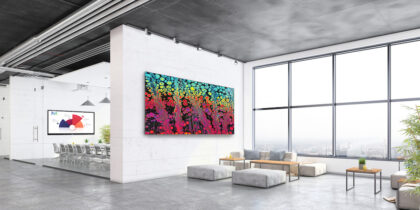There are endless technical arguments for determining which screens are the best, but if you set price aside, the deciding factor usually comes down to which screen produces the best visuals — the most accurate depiction of the world as we see it with our own eyes.
Leading screen manufacturers like Samsung have turned to nanotechnology that, ironically, can’t even be seen by the naked eye but produces jaw-droppingly rich, vibrant displays. An emerging technology called Quantum Dot enhances flat-panel LED displays, commercial TVs and curved widescreen monitors, revealing many more colors and adding the necessary brightness to take full advantage of technologies like High Dynamic Range (HDR).
Quantum Dots are essentially nanoparticles that manufacturers add to the layers of films, filters, glass and electronics — sometimes called the sandwich — that comprise a Liquid Crystal Display (LCD). When these Quantum Dots are illuminated, they re-emit light of a certain color. Developing the technology for the primary QLED colors (red, blue and green) has been a technological feat, and one Samsung has overcome with its R&D hub Samsung Advanced Institute of Technology (SAIT). The team successfully developed blue QLED technology in 2020.
Because of its investment in R&D, Samsung is, by far, the market leader in Quantum Dots development and display products, with a category it calls Quantum LED (QLED). Other display manufacturers using Quantum Dots technology often include “Q” or “Quantum” in product names to make the distinction from conventional LCDs.
Quantum Dots-enhanced displays compare favorably with super-premium Organic LED displays (OLEDs), but usually at less cost, and with none of the technical issues and limitations that OLED introduces (more on that later). Quantum Dots technology first found its way into the premium TV market, and is now increasingly being used by image-sensitive brands for commercial applications such as digital signage, where the depth and accuracy of color is critically important.
Quantum Dots explained
What is Quantum Dot technology? A Quantum Dot is a human-made nanoparticle that has semiconductor properties. They’re tiny, ranging in size from two to 10 nanometers, with the size of the particle dictating the wavelength of light it emits, and therefore the color. When Quantum Dots are hit with a light source, each dot emits a color of a specific bandwidth: Larger dots emit light that is skewed toward red, and progressively smaller dots emit light that is skewed more toward green.
[related promo]
Quantum Dots are usually applied to a sheet of film that sits as a layer in that “sandwich” in front of the LED backlight that’s used to illuminate an LCD. The light passes through the LCD display stack, with the Quantum Dot color filter layer enhancing and enabling the LCD to reveal a wider and more saturated range of colors than would otherwise be possible.
Color is key
With Samsung’s Quantum Dots technology, it’s all about the colors.
Many consumer and B2B brands place heavy importance on how their products look to the marketplace. Their brands’ colors are not just blue and red — they are very specific blues and reds. Brand owners often have rigorous guidelines that mandate how these colors are reproduced, and in the case of digital displays, Quantum Dots technology provides the level of accuracy they want. Samsung’s QLED displays, for example, enable more than a billion colors.
By one estimate, Quantum Dots increase the color gamut on LCD displays by up to 50 percent. That broad range of colors also enables more saturated colors — the vivid, intense color levels that “pop” on screens and draw viewer attention.
Using Quantum Dots means the range of colors and their accuracy is maintained even at peak brightness, while other display technologies like OLED might wash out colors when scenes require full brightness. The result with QLED is accurate, rich and detailed colors on displays, in any light.
QLED vs. OLED
Quantum Dots LCD displays are often compared to OLED flat panel displays, with both billed as premium visual experiences. To a casual observer, they can look very similar, but there are distinct differences.
In pure technical terms, they’re different in that LCDs are illuminated by integrated but distinct LED lighting arrays, whereas OLEDs are self-emissive — each pixel is its own light.
Both technologies offer a huge range of colors, delivering eye-popping visuals. But while Quantum Dots can reproduce that full range of colors even at peak brightness, when the image on an OLED display becomes too bright, its color capabilities are compromised, and diminishing the available spectrum. Samsung QLEDs have peak brightness levels as high as 4,000 nits, which is brighter than what’s needed for outdoor displays to overpower the glare of direct sunlight.
While a QLED will provide consistent color expression throughout its operating life, the organic material driving an OLED will fade (in technical terms, lose that color expression) as it ages. OLEDs — particularly running at high brightness — are also more susceptible to burn-in, or ghosts of images or text left when a screen element (such as a logo) stays up for too long.
Inspiring viewing
When flat panel displays first came into the marketplace, much of the marketing story and buyer interest focused on their shape and scale. Then the focus turned to resolution, shifting from 720p to 1080p HD and then to 4K and even 8K.
Size and pixel counts are important, but in many respects the real determining factors for brands and business users is visual quality. The real benefits of Full HD, Ultra HD and beyond come when a display can deliver that volume of detail with an exceptional depth of color, no matter the visuals. Samsung’s QLED technology is supported by AI-powered machine learning, which can scale 4K UHD and Full HD content to 8K resolution without compromising quality.
Quantum Dots may seem like a term that could only excite nerds, but one look at a QLED display will generate admiration even from people who don’t want to know all the technical details.
Explore Samsung’s full lineup of QLED displays, designed deliver realistic detail and vibrant color to showcase your business in the best light. Looking for more buying advice? You can find everything you need to know about choosing your LED displays for optimal viewing indoors and out in this free, comprehensive guide.






